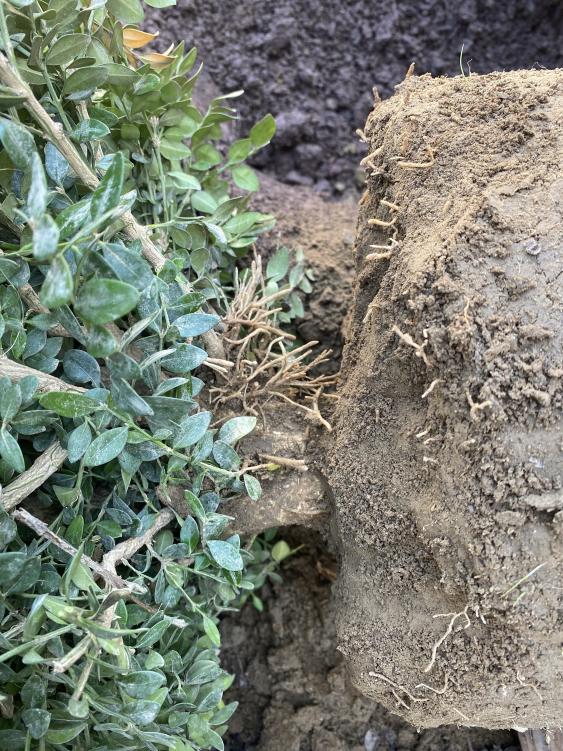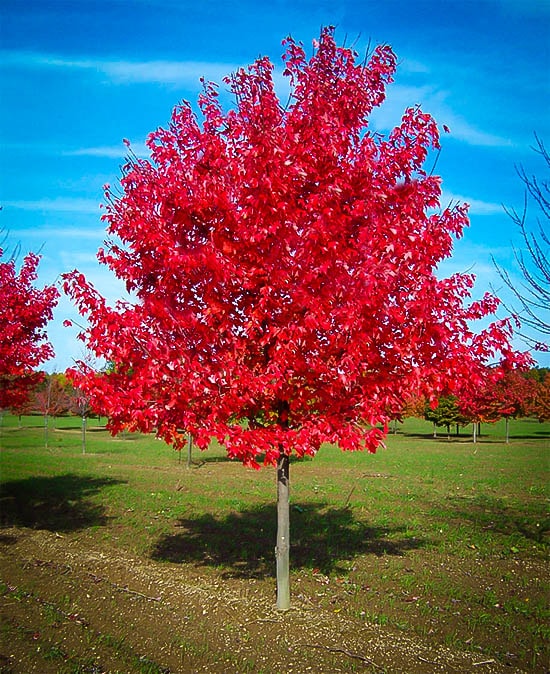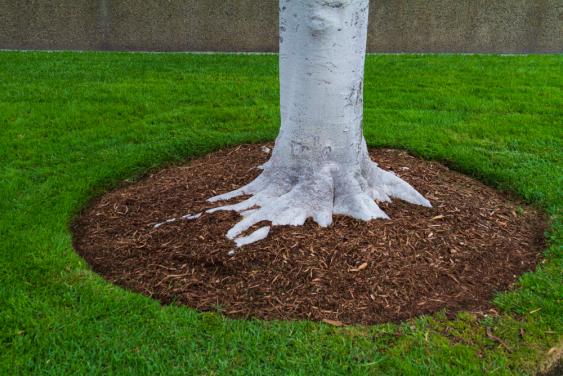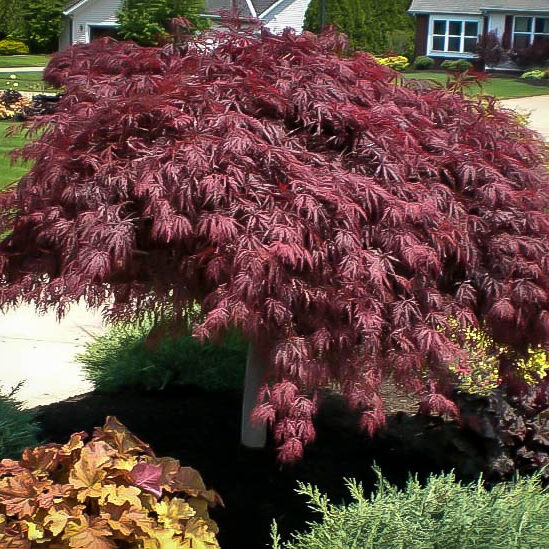Red sunset Maple Tree. Photo Credit: The Tree Center
“The best time to plant a tree was 20 years ago… the second best time is now.”
Trees add a tremendous aesthetic value to your property as well as increase property values up to 15 percent. Since they are a major investment, choosing the right tree for your landscape and planting it correctly will insure that your tree will thrive and give you years of enjoyment.
How Will Your Tree Be Used in the Landscape?
All homeowners have specific reasons for planting a tree. When you establish what you want the tree to achieve, it will help you narrow your choices. Ask yourself these questions:
- Do you want your tree to provide shade?
- Will the tree become a focal point in your yard?
- Will the tree provide privacy or block an unsightly view?
- To narrow the decision down more, consider height, spread, evergreen or deciduous, attractive flower or fruit, low water requirements, and soil adaptability.
This tree is properly mulched with root flare above grade.
What Qualities Are You Looking for in Your Tree?
All trees have specific benefits such as providing shade, saving energy, limiting maintenance. More questions to ask oneself?
- Do you want it to cool your house in the summer and allow the winter sun warm you?
- Are you partial to a color? Want beautiful, fall foliage? Want spring colorful flowers?
- Do you mind leaf maintenance or would an evergreen suit your taste?
Red Maple is a moderately fast-growing PA-native shade tree best known for its brilliant red fall foliage. Some varieties grow 40 to 50 feet tall. Photo Credit: The Tree Center
Key Points to Consider when Selecting the Right Tree
– Give careful consideration to the site in which you’ll be planting. Evaluate the slope, soil type, hardiness zone, wind, sun exposure, soil compaction, disease and insect resistant, drainage, and space.
– Choose a tree according to the amount of sunlight the site will receive. Morning sun and afternoon shade is significantly different than a site that gets morning shade and afternoon sun.
– Most trees like well-drained soil and if your yard retains water, it may be susceptible to root rot. Compacted soil that doesn’t drain well is a leading killer of trees.
– Know how big a tree is going to get in the future and choose accordingly. Be aware of obstacles such as power lines.
– Resist the desire for an ‘instant landscape’. Smaller, younger trees will start growing faster than you think.
– Native trees make excellent landscape choices. They tolerate local conditions without a lot of extra water or high maintenance and aid the birds, bees, and other local wildlife.
Click here for a list of Native Pennsylvania Trees.
How to Plant a Tree
Step 1 – Prep the Area. Remove the grass in your planting area. Cut in or install the bed edge.
Step 2 – Dig the Hole. The size of the hole plays a major role in how quickly a tree establishes itself and grows. Dig the hole that is the same depth as your plant’s root ball but two times as wide. Be mindful you’ll be mulching too, so don’t dig too deep.
Step 3 – Prep the Tree. If the roots are root bound, slice the outer layer of roots away which will encourage new roots to grow, and the new ones will grow out rather than circling around. The soil around the root ball and at the site can benefit from being moist before planting the day before you plant.
Step 4 – Planting. Fill the hole with the same native soil that you dug out to create the hole. It’s not necessary to add or amend the soil unless you’re planting where the topsoil has been removed and the subsoil is heavily compacted (like new home sites). Backfill about half the hole and water it in. Once it drains, finish filling the hole. No need to fertilize.
*If the tree’s root ball is enclosed in a wire basket, cut it off and remove it. Cut the twine wrapped around the trunk before cutting away the burlap.
*Plant so the root flare (the widened base of the trunk just above the roots) is above grade. If your purchased tree has too much soil covering the roots and trunk, remove any excess soil.
Step 5 – Mulching. Mulch the tree as far out as the branches reach (dripline) is better than having grass growing up to the trunk. Do not place mulch up against the base of tree.
Step 6 – Don’t Forget to Water. Regular watering for about a year is important to tree establishment. Water when the soil below the mulch and in the root ball feels dry at a depth of several inches. A good method is to set a hose at a trickle and run it for around 20 minutes at the base of the tree. However, be careful to not over water, causing the leaves to turn yellow and drop.

An example of a shrub at a nursery where there is too much soil covering the roots and you can actually see roots extending from the branches. Excess soil needs to be removed before planting.
Whitehouse Landscaping: A Full Service Landscaping Company in Southeastern, PA
Whitehouse Landscaping has been designing, installing and maintaining beautiful custom landscaping and hardscaping in Montgomery, Chester, and Berks counties, PA since 2000. We have the horticultural knowledge to make sure the right plants are chosen for the right placing insuring your landscape thrives and can be properly maintained.
Look to the experts at Whitehouse Landscaping for all your design, build and maintenance needs in Southeastern, PA. Get started by requesting a free consultation today or call 484-300-4290. We’re always happy to help you.



